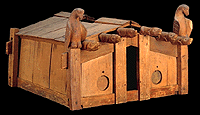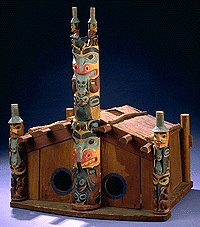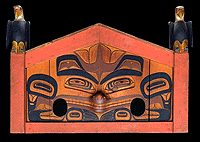
Haida house models
 |
CMC VII-X-124 Haida sculptures range from tall totem poles to the equally complex carved handles of horn spoons. This ability to express artistic concepts over a range of sizes and forms has attracted the admiration of art afficionados worldwide. Following the tragic depopulation of the late 1860s due to epidemics, and deculturation in the 1870s and 1880s, the monumental sculptural tradition was abandoned. Carvers miniaturized their production into models of houses and poles, tailoring their art to the tourist market. House models were a favourite souvenir of early tourists, and Haida carvers embellished them with every conceivable decoration. The Haida viewed the universe as a large house, with the sides being the four cardinal directions. Not a single complete original Haida dwelling survives, but there are historical photographs of about four hundred Haida houses in twenty-five villages, and nearly one hundred house models survive in museum collections. |
 |
Model of Monster House. Collected before 1914 by Thomas Deasey. One exquisite house model from Masset is a relatively authentic portrayal of Chief Wiah's Monster House, carved for Indian agent Thomas Deasey by Charles Edenshaw. As the historical photos show, that house did indeed have carved corner posts, as well as a large frontal pole depicting the flood story of Qingi, whose large bearlike figure sits atop both the model pole and the real pole. The Eagle, a crest of Wiah's, takes flight from Qingi's head. The actual house was the largest ever built by the Haida. |
 |
Model of Grizzly Bear's Mouth House. Acquired at Skidegate before 1900 for the Lord Bossom collection. CMC VII-B-1556 A model of Chief Giatlins' Grizzly Bear's Mouth House, one of the most unusual buildings in Skidegate, was made about 1890 by John Robson (a later Chief Giatlins), a leading Skidegate carver who inherited the house. It coincides closely with a photo of the house taken in 1878. The house was a six-beam structure in which the decoration was both carved and painted onto the thick vertical planks that were inserted into the gables of the housefront. The housefront was sculpted as well as painted, particularly the snout of the Bear, which protruded out quite a way from the painted portion. Two oval doorways were positioned at the corners of the Bear's mouth. The Eagles on the corner posts are crests that belonged to the owner's wife. |
